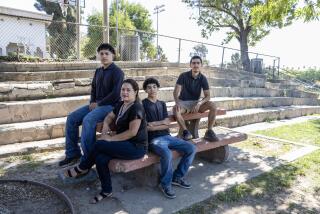Immigration reform: Who qualifies and who doesn’t?
Reporting from Washington — President Obama’s new set of immigration policies could affect up to 5 million people, including the possibility of a three-year reprieve from the threat of deportation for some parents of residents with legal status.
In addition, the administration has laid out important shifts in how agents will enforce immigration laws to focus more on deporting people with lengthy or violent criminal records, and less on people whose only crimes are immigration offenses. The new approach will end the dragnet system that enlisted local police in blowing the whistle on people here illegally.
However, the administration is not offering a path to legal status or citizenship. And the revamped policies won’t apply to most of the estimated 11.2 million people living in the country illegally.
Here’s a look at how the policies will work.
Whom is the new plan designed to help?
The largest share are immigrants who came to the U.S. illegally and who have children who are citizens (nearly all children born in the U.S. are automatically citizens) or permanent legal residents. To be eligible, people have to have been living in the U.S. since Jan. 1, 2010, and have no record of serious crimes that would make them a priority for removal.
A White House legal memo said this “would serve an important humanitarian interest in keeping parents together with children who are lawfully present in the United States.” Approved applicants will get permission to stay for three years. As many as 4.1 million people could fit the criteria, the administration estimates. The application will cost $465.
What about people who came to the U.S. as children?
The program expands the 2012 Deferred Action for Childhood Arrivals program, known as DACA, that has protected 587,000 young people from removal. The new rules do away with an age limit and open the program to anyone here since 2010, instead of the old cutoff year of 2007. An estimated 300,000 additional young men and women would be eligible.
Does this mean these people will become legal residents?
No. As laid out by Obama and Homeland Security Secretary Jeh Johnson, the administration is using its discretion in not targeting these immigrants for deportation. Absent other changes, such as a law passed by Congress, the immigrants could again go into illegal status after their temporary reprieves expire.
Where are most of these people from, and where do they live now?
About two-thirds are from Mexico, the source of most immigrants to the U.S. The biggest share of the eligible parents, more than 1.1 million, live in California, with the next biggest populations in Texas and Illinois.
What about the 6 million people who don’t qualify?
Some arrived in the U.S. too recently to qualify, but most are excluded because they didn’t have kids born here. According to the Pew Research Center, which studies immigration, about 85% of people who live here without authorization have been here for five years or more. That’s because illegal immigration has been down in recent years, said Jeff Passel, Pew’s senior demographer. The biggest share of the people who’ve lived here long enough but still don’t qualify are single men, he said. Others are married without kids. Some have children who were born elsewhere: For instance, parents of children born in Mexico and brought to the U.S. as toddlers aren’t eligible.
Is the new program open to parents of kids who’ve already received a reprieve under DACA?
No. Administration lawyers decided that was a bridge too far, without legal basis, since there would be no family member with legal status in the U.S. – only children with a temporary relief order. That decision disappointed some immigration activists, who point out that those families could be split up.
If someone met these qualifications – in the U.S. for five years, with American-born kids — but got deported, can they now apply to get back in?
No. Those cases are considered closed by immigration officials. As many as 250,000 to 300,000 people might fit that category, according to Randy Capps, director of research for the nonprofit Migration Policy Institute. However, the new policy says that people who are subject to deportation actions — even those who have received final removal orders, but are still in the U.S. — can apply to stay.
How will enforcement change under the new rules?
The administration says its top priority will be to go after border crossers and people considered dangerous, such as convicted felons and gang members. The second priority is people convicted of at least three misdemeanor crimes, or who have committed “significant” offenses such as domestic violence or drug trafficking.
At the bottom of the list: people who have committed no crimes other than illegally entering the country, particularly if they’ve been in the U.S. since Jan. 1 of this year. The administration is doing away with the much-derided Secure Communities program, which enlisted local police to hold unauthorized people on detainers for immigration agents. The government will still collect fingerprint data, though.
Who else could benefit?
Also in the works are changes to rules for granting visas for science and technology students, and changes to streamline the clunky and inflexible rules on work visas, to make it easier for people to switch jobs without jeopardizing their immigration status.
joseph.tanfani@latimes.com
Times staff writers David G. Savage and Brian Bennett contributed to this report.
More to Read
Sign up for Essential California
The most important California stories and recommendations in your inbox every morning.
You may occasionally receive promotional content from the Los Angeles Times.











